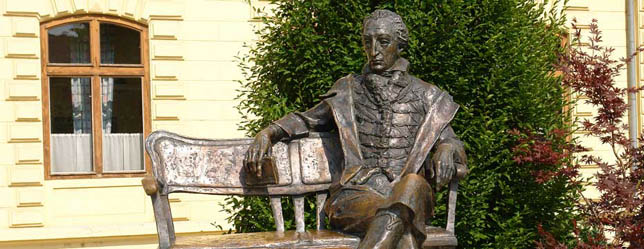
On the main square of Keszthely there were different statues through different ages. In 1902 that of the standing statue of György Festetics was unveiled which later in 1948 got demolished. In its place a Russian war memorial was placed and during the revolution it was knocked over. In front of the ruins Festetics’s statue was placed after having been taken away from the cellar of Balaton Museum and in 1957 it was taken back to the cellar again. Although György Festetics was rehabilitated in the 60s, the statue could not be replaced to its original place because another war monument was to be put on its place but the idea was finally gone with the wind of history. On the square -uniquely in Keszthely – Memorial of 1956 was standing also the same place where now the statue of the Palatine Lackfi on horseback is.
Festetics statue having been stored in a cellar stands at the entrance of the castle today.
Festetics György’s I. statue ,the work of Ferenc Farkas, a Herman Lipót prize winner sculpture was put on a territory having been empty for many years 3rd June in 2006. The full-sized figure bronze statue symbolizing the Maecenas count in sitting position, dressed in period dress became the favourite of the town and the tourists already at its delivery. The composition was put on a 6 meter diameter round square covered with lime stone and it is the elemental part of the composition with the footpath.
The cooler-figures in Rolls. Royce cars are made with this technology too but this method is used in dental technique as well. By 23 October 2006 got the town to set up the work of 1956 evoking a so called white man on the southern part of the square between the church and the fountain. The name ’white man’ derives from the fact that the first, original statue was white, made of plaster. The curiosity of the present statue is its broken flag. The flag seems to be one only from a marked point on the round pedestal.


